Highly Transparent and Zirconia-Enhanced Sol-Gel Hybrid Coating on Polycarbonate Substrates for Self-Cleaning Applications
Abstract
:1. Introduction
2. Experimental
2.1. Materials
2.2. Treatment of Substrate Materials
2.3. Synthesis of Mixed Zirconium Oxide and Silica Sols
2.4. Preparation of Mixed Sol-Gel Coating
2.5. Surface Modification of the Hybrid Coating
2.6. Characterizations
3. Results and Discussion
3.1. Optical Property
3.2. Surface Morphology
3.3. Chemical Compositions
3.4. Wettability, Mechanism of Surface Hydrophobicity, and Self-Cleaning
3.5. Mechanical Stability and Durability
3.5.1. Sandpaper Abrasion Test
3.5.2. Sand Hit Test
3.5.3. Adhesion Scratch Test
3.5.4. Water-Drop Impact Test and Stability Test
4. Conclusions
Author Contributions
Funding
Institutional Review Board Statement
Informed Consent Statement
Data Availability Statement
Acknowledgments
Conflicts of Interest
References
- Park, J.Y.; Ham, J.; Lee, I.; Lee, J. A Strain Induced Subwavelength-Structure for a Haze-Free and Highly Transparent Flexible Plastic Substrate. Nanoscale 2018, 10, 14868–14876. [Google Scholar] [CrossRef]
- Chen, Y.; Huang, Z.; Yang, H. Cicada-Wing-Inspired Self-Cleaning Antireflection Coatings On Polymer Substrates. ACS Appl. Mater. Inter. 2015, 7, 25495–25505. [Google Scholar] [CrossRef]
- Fabbri, P.; Leonelli, C.; Messori, M.; Pilati, F.; Toselli, M.; Veronesi, P.; Morlat-Thérias, S.; Rivaton, A.; Gardette, J.L. Improvement of the Surface Properties of Polycarbonate by Organic-Inorganic Hybrid Coatings. J. Appl. Polym. Sci. 2008, 108, 1426–1436. [Google Scholar] [CrossRef]
- El-Bashir, S.M.; Barakat, F.M.; AlSalhi, M.S. Double Layered Plasmonic Thin-Film Luminescent Solar Concentrators Based On Polycarbonate Supports. Renew. Energy 2014, 63, 642–649. [Google Scholar] [CrossRef]
- Azulai, D.; Givan, U.; Shpaisman, N.; Belenkova, T.L.; Gilon, H.; Patolsky, F.; Markovich, G. On-Surface Formation of Metal Nanowire Transparent Top Electrodes On Cdse Nanowire Array-Based Photoconductive Devices. ACS Appl. Mater. Inter. 2012, 4, 3157–3162. [Google Scholar] [CrossRef] [PubMed]
- Zhao, Y.; Zhang, J.; Xu, Q.; Mi, H.; Zhang, Y.; Li, T.; Sun, H.; Han, J.; Liu, C.; Shen, C. Ultrastable and Durable Silicone Coating On Polycarbonate Surface Realized by Nanoscale Interfacial Engineering. ACS Appl. Mater. Inter. 2020, 12, 13296–13304. [Google Scholar] [CrossRef] [PubMed]
- Kim, N. Recent Progress of Functional Coating Materials and Technologies for Polycarbonate. J. Coat. Technol. Res. 2017, 14, 21–34. [Google Scholar] [CrossRef]
- De Vietro, N.; Belforte, L.; Lambertini, V.G.; Fracassi, F. Low Pressure Plasma Modified Polycarbonate: A Transparent, Low Reflective and Scratch Resistant Material for Automotive Applications. Appl. Surf. Sci. 2014, 307, 698–703. [Google Scholar] [CrossRef]
- Seubert, C.; Nietering, K.; Nichols, M.; Wykoff, R.; Bollin, S. An Overview of the Scratch Resistance of Automotive Coatings: Exterior Clearcoats and Polycarbonate Hardcoats. Coatings 2012, 2, 221–234. [Google Scholar] [CrossRef]
- Le Bail, N.; Lionti, K.; Benayoun, S.; Pavan, S.; Thompson, L.; Gervais, C.; Dubois, G.; Toury, B. Scratch-Resistant Sol–Gel Coatings On Pristine Polycarbonate. New J. Chem. 2015, 39, 8302–8310. [Google Scholar] [CrossRef]
- Präfke, C.; Schulz, U.; Kaiser, N. Preparation and Characterization of Organic Layers for Uv Protection of Polycarbonate. Thin Solid Films 2012, 520, 4180–4183. [Google Scholar] [CrossRef]
- Fabbri, P.; Messori, M.; Toselli, M.; Veronesi, P.; Rocha, J.; Pilati, F. Enhancing the Scratch Resistance of Polycarbonate with Poly(Ethylene Oxide)-Silica Hybrid Coatings. Adv. Polym. Technol. 2008, 27, 117–126. [Google Scholar] [CrossRef]
- Tanglumlert, W.; Prasassarakich, P.; Supaphol, P.; Wongkasemjit, S. Hard-Coating Materials for Poly(Methyl Methacrylate) From Glycidoxypropyltrimethoxysilane-Modified Silatrane Via a Sol–Gel Process. Surf. Coat. Technol. 2006, 200, 2784–2790. [Google Scholar] [CrossRef]
- Cui, L.; Lionti, K.; Ranade, A.; Larson-Smith, K.; Dubois, G.J.; Dauskardt, R.H. Highly Transparent Multifunctional Bilayer Coatings On Polymers Using Low-Temperature Atmospheric Plasma Deposition. ACS Nano 2014, 8, 7186–7191. [Google Scholar] [CrossRef] [PubMed]
- Nakayama, N.; Hayashi, T. Synthesis of Novel Uv-Curable Difunctional Thiourethane Methacrylate and Studies On Organic–Inorganic Nanocomposite Hard Coatings for High Refractive Index Plastic Lenses. Prog. Org. Coat. 2008, 62, 274–284. [Google Scholar] [CrossRef]
- Schmauder, T.; Nauenburg, K.D.; Kruse, K.; Ickes, G. Hard Coatings by Plasma Cvd On Polycarbonate for Automotive and Optical Applications. Thin Solid Films 2006, 502, 270–274. [Google Scholar] [CrossRef]
- Fortuna, S.V.; Sharkeev, Y.P.; Perry, A.J.; Matossian, J.N.; Shulepov, I.A. Microstructural Features of Wear-Resistant Titanium Nitride Coatings Deposited by Different Methods. Thin Solid Films 2000, 377–378, 512–517. [Google Scholar] [CrossRef]
- Sun, Y.; Rawat, R.S.; Chen, Z. Mechanically Robust Anti-Fingerprint Coating On Polycarbonate Substrate. Appl. Surf. Sci. 2022, 597, 153706. [Google Scholar] [CrossRef]
- Wu, L.Y.L.; Tan, G.H.; Zeng, X.T.; Li, T.H.; Chen, Z. Synthesis and Characterization of Transparent Hydrophobic Sol-Gel Hard Coatings. J. Sol-Gel Sci. Techn. 2006, 38, 85–89. [Google Scholar] [CrossRef]
- Sepeur, S.; Kunze, N.; Werner, B.; Schmidt, H. Uv Curable Hard Coatings On Plastics. Thin Solid Films 1999, 351, 216–219. [Google Scholar] [CrossRef]
- Hench, L.L.; West, J.K. The Sol-Gel Process. Chem. Rev. 1990, 90, 33–72. [Google Scholar] [CrossRef]
- Colomer, M.T. Straightforward Synthesis of Ti-Doped Ysz Gels by Chemical Modification of the Precursors Alkoxides. J. Sol-Gel Sci. Techn. 2013, 67, 135–144. [Google Scholar] [CrossRef]
- Nakonieczny, D.S.; Paszenda, Z.K.; Basiaga, M.; Radko, T.; Drewniak, S.; Podwórny, J.; Bogacz, W. Phase Composition and Morphology Characteristics of Ceria-Stabilized Zirconia Powders Obtained Via Sol-Gel Method with Various Ph Conditions. Acta Bioeng. Biomech. 2017, 19, 21–30. [Google Scholar]
- Nakonieczny, D.; Paszenda, Z.; Drewniak, S.; Radko, T.; Lis, M. SZrO2-CeO2 Ceramic Powders Obtained From a Sol-Gel Process Using Acetylacetone as a Chelating Agent for Potential Application in Prosthetic Dentistry. Acta Bioeng. Biomech. 2016, 18, 53–60. [Google Scholar]
- Sabhya; Kompa, A.; Kekuda, D.; Murari, M.S.; Rao, K.M. Influence of Hf Precursor Concentration On Various Properties of Sol-Gel Based Spin Coated HfO2 Thin Films. Opt. Mater. 2023, 136, 113424. [Google Scholar] [CrossRef]
- Lenza, R.F.S.; Nunes, E.H.M.; Vasconcelos, D.C.L.; Vasconcelos, W.L. Preparation of Sol–Gel Silica Samples Modified with Drying Control Chemical Additives. J. Non-Cryst. Solids 2015, 423–424, 35–40. [Google Scholar] [CrossRef]
- Le Bail, N.; Benayoun, S.; Toury, B. Mechanical Properties of Sol–Gel Coatings On Polycarbonate: A Review. J. Sol-Gel Sci. Techn. 2015, 75, 710–719. [Google Scholar] [CrossRef]
- Lakshmi, R.V.; Bharathidasan, T.; Basu, B.J. Superhydrophobic Sol–Gel Nanocomposite Coatings with Enhanced Hardness. Appl. Surf. Sci. 2011, 257, 10421–10426. [Google Scholar] [CrossRef]
- Xu, Q.F.; Wang, J.N.; Sanderson, K.D. Organic−Inorganic Composite Nanocoatings with Superhydrophobicity, Good Transparency, and Thermal Stability. ACS Nano 2010, 4, 2201–2209. [Google Scholar] [CrossRef]
- Eshaghi, A. Transparent Hard Self-Cleaning Nano-Hybrid Coating On Polymeric Substrate. Prog. Org. Coat. 2019, 128, 120–126. [Google Scholar] [CrossRef]
- Liang, L.; Xu, Y.; Wu, D.; Sun, Y. A Simple Sol–Gel Route to ZrO2 Films with High Optical Performances. Mater. Chem. Phys. 2009, 114, 252–256. [Google Scholar] [CrossRef]
- Tana, F.; Messori, M.; Contini, D.; Cigada, A.; Valente, T.; Variola, F.; De Nardo, L.; Bondioli, F. Synthesis and Characterization of Scratch-Resistant Hybrid Coatings Based On Non-Hydrolytic Sol-Gel ZrO2 Nanoparticles. Prog. Org. Coat. 2017, 103, 60–68. [Google Scholar] [CrossRef]
- Mathur, S.; Ruegamer, T. Transparent and Scratch-Resistant C:Zrox Coatings On Polymer and Glass by Plasma-Enhanced Chemical Vapor Deposition. Int. J. Appl. Ceram. Tec. 2011, 8, 1050–1058. [Google Scholar] [CrossRef]
- Suriano, R.; Ciapponi, R.; Griffini, G.; Levi, M.; Turri, S. Fluorinated Zirconia-Based Sol-Gel Hybrid Coatings On Polycarbonate with High Durability and Improved Scratch Resistance. Surf. Coat. Technol. 2017, 311, 80–89. [Google Scholar] [CrossRef]
- Lopez De Armentia, S.; Pantoja, M.; Abenojar, J.; Martinez, M. Development of Silane-Based Coatings with Zirconia Nanoparticles Combining Wetting, Tribological, and Aesthetical Properties. Coatings 2018, 8, 368. [Google Scholar] [CrossRef]
- He, G.; Lu, S.; Xu, W.; Ye, P.; Liu, G.; Wang, H.; Dai, T. Stable Superhydrophobic Zn/ZnO Surfaces Fabricated Via Electrodeposition On Tin Substrate for Self-Cleaning Behavior and Switchable Wettability. J. Alloys Compd. 2018, 747, 772–782. [Google Scholar] [CrossRef]
- Lomga, J.; Varshney, P.; Nanda, D.; Satapathy, M.; Mohapatra, S.S.; Kumar, A. Fabrication of Durable and Regenerable Superhydrophobic Coatings with Excellent Self-Cleaning and Anti-Fogging Properties for Aluminium Surfaces. J. Alloys Compd. 2017, 702, 161–170. [Google Scholar] [CrossRef]
- Ragesh, P.; Anand Ganesh, V.; Nair, S.V.; Nair, A.S. A Review On ‘Self-Cleaning and Multifunctional Materials’. J. Mater. Chem. A Mater. Energy Sustain. 2014, 2, 14773–14797. [Google Scholar] [CrossRef]
- De, S.; Jana, D.; Medda, S.K.; De, G. Wavelength Selective Antireflective Coatings On Plastics with Hydrophobic Surfaces. Ind. Eng. Chem. Res. 2013, 52, 7737–7745. [Google Scholar] [CrossRef]
- Lü, G.; Yang, B. High Refractive Index Organic–Inorganic Nanocomposites: Design, Synthesis and Application. J. Mater. Chem. 2009, 19, 2884. [Google Scholar] [CrossRef]
- Yuan, R.; Liu, H.; Chen, Y.; Liu, Z.; Li, Z.; Wang, J.; Jing, G.; Zhu, Y.; Yu, P.; Wang, H. Design Ambient-Curable Superhydrophobic/Electroactive Coating Toward Durable Pitting Corrosion Resistance. Chem. Eng. J. 2019, 374, 840–851. [Google Scholar] [CrossRef]
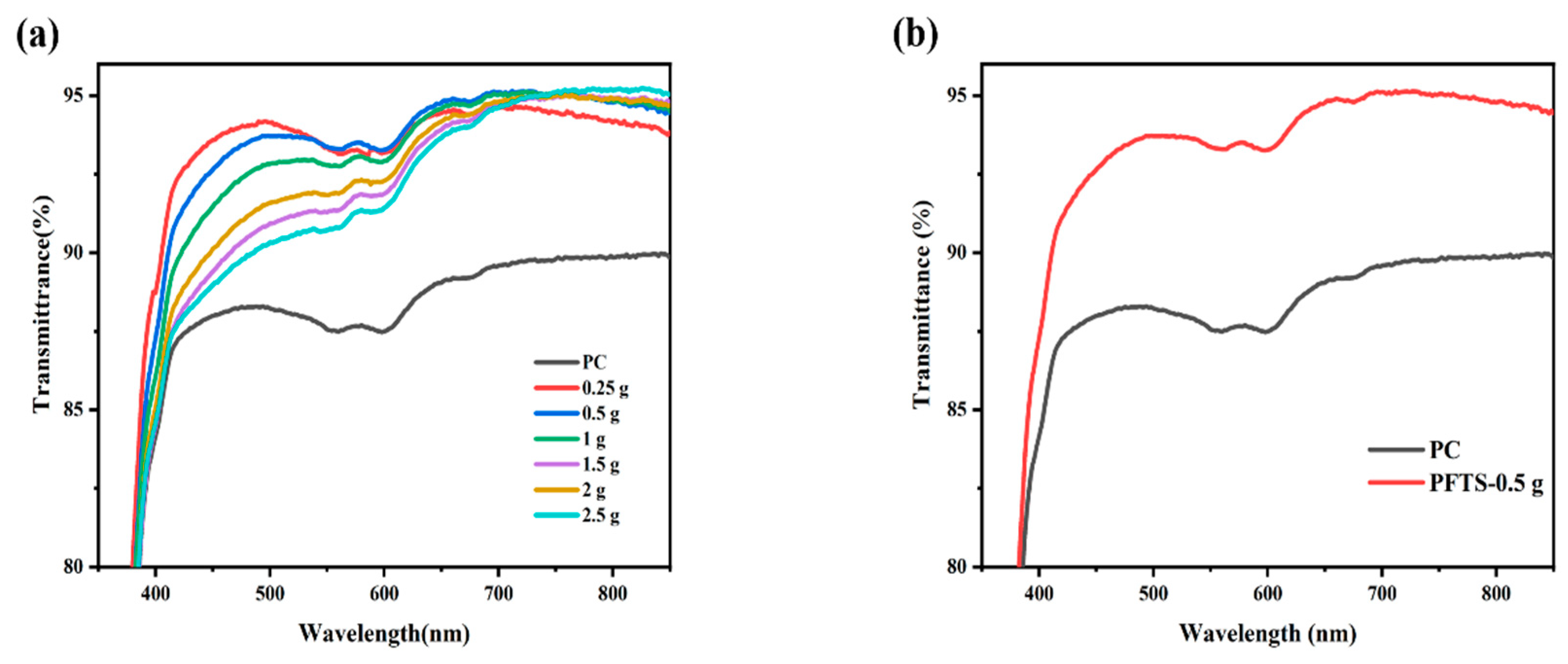
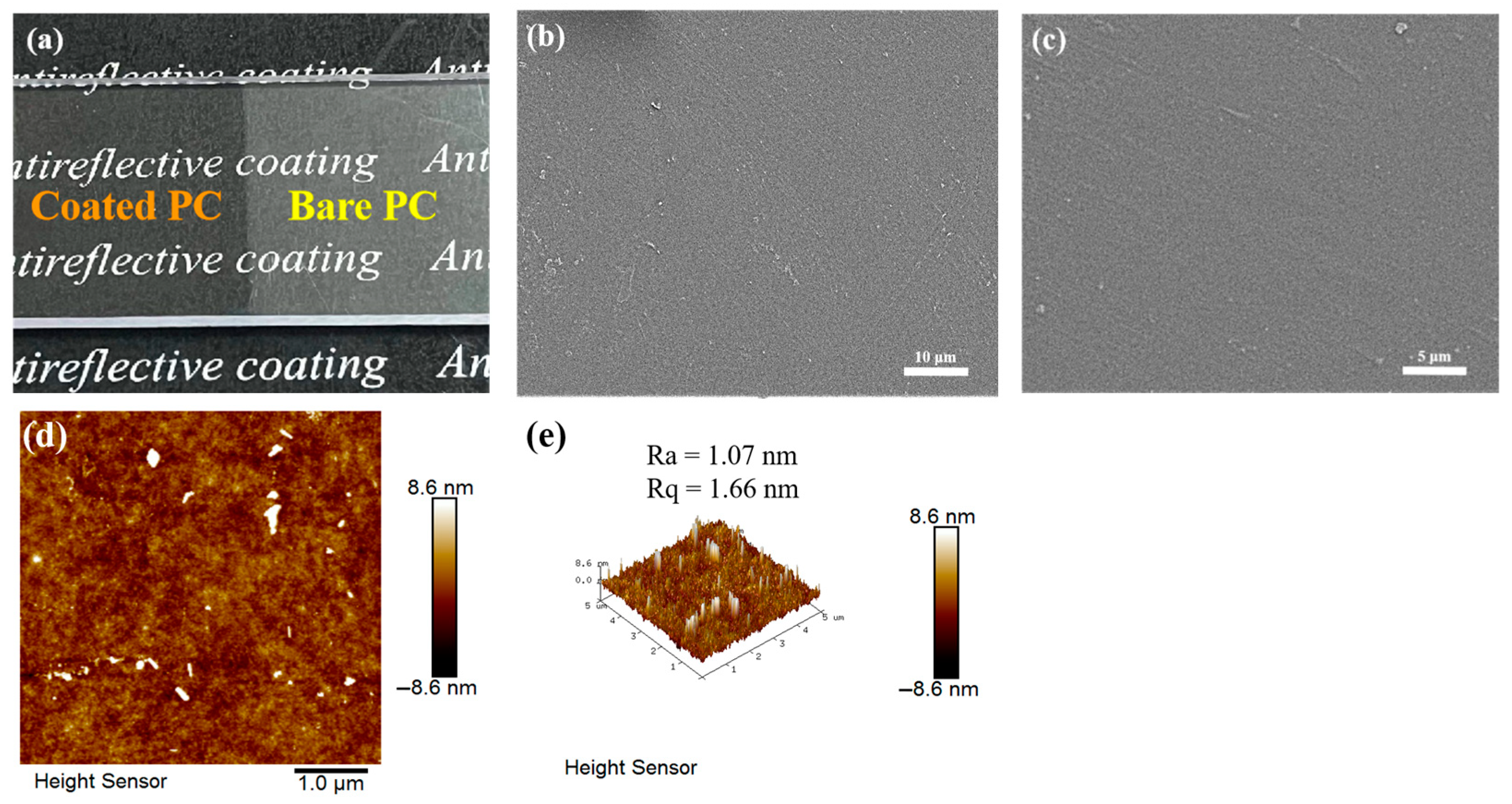

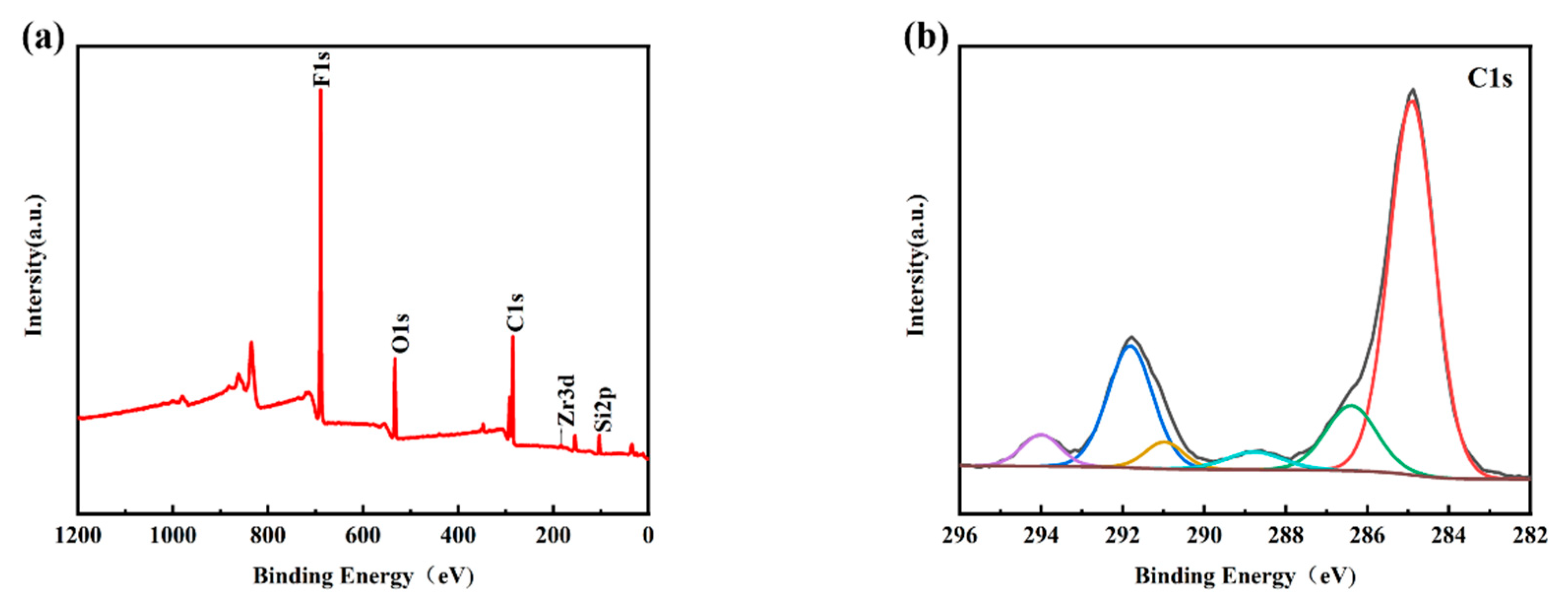
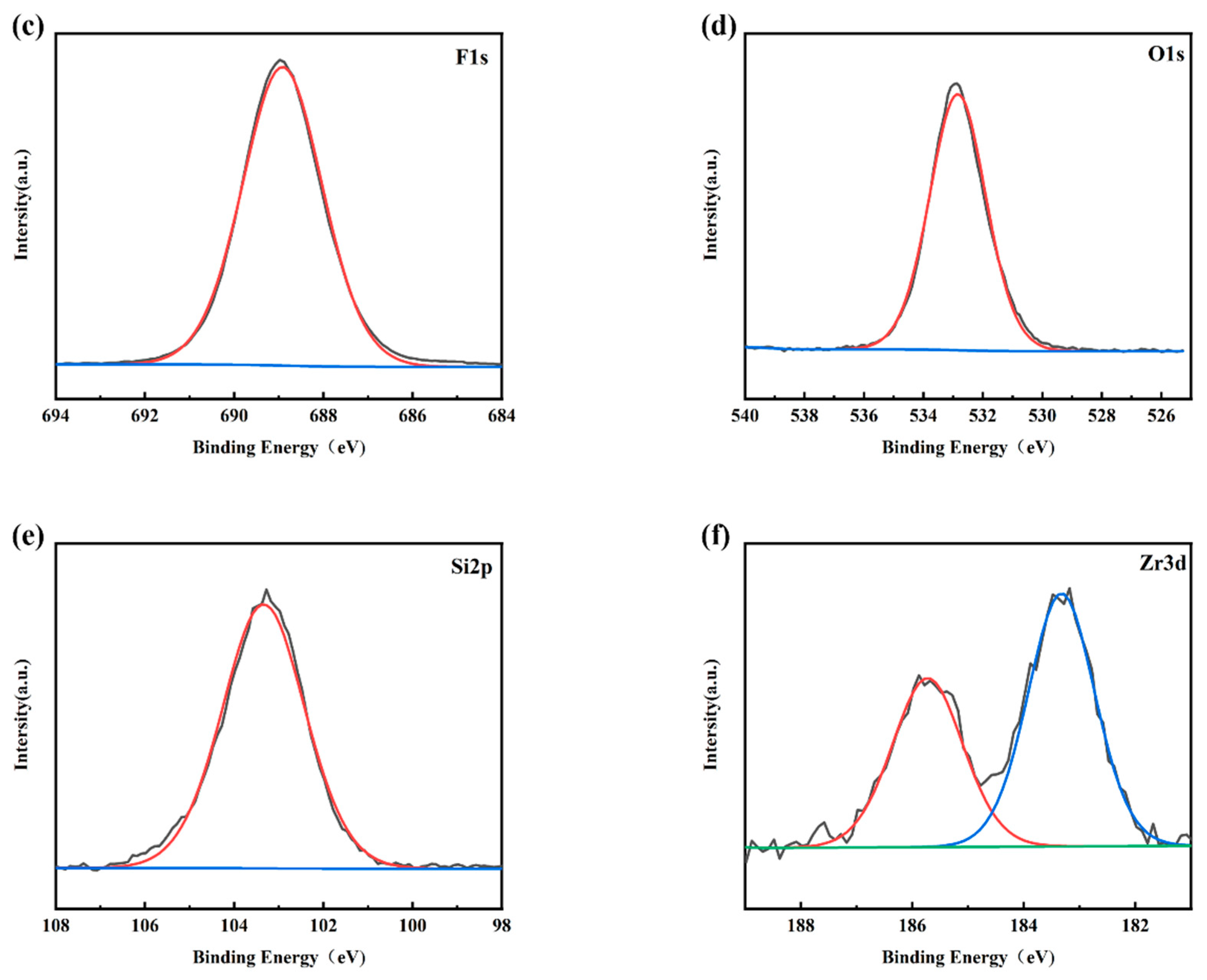

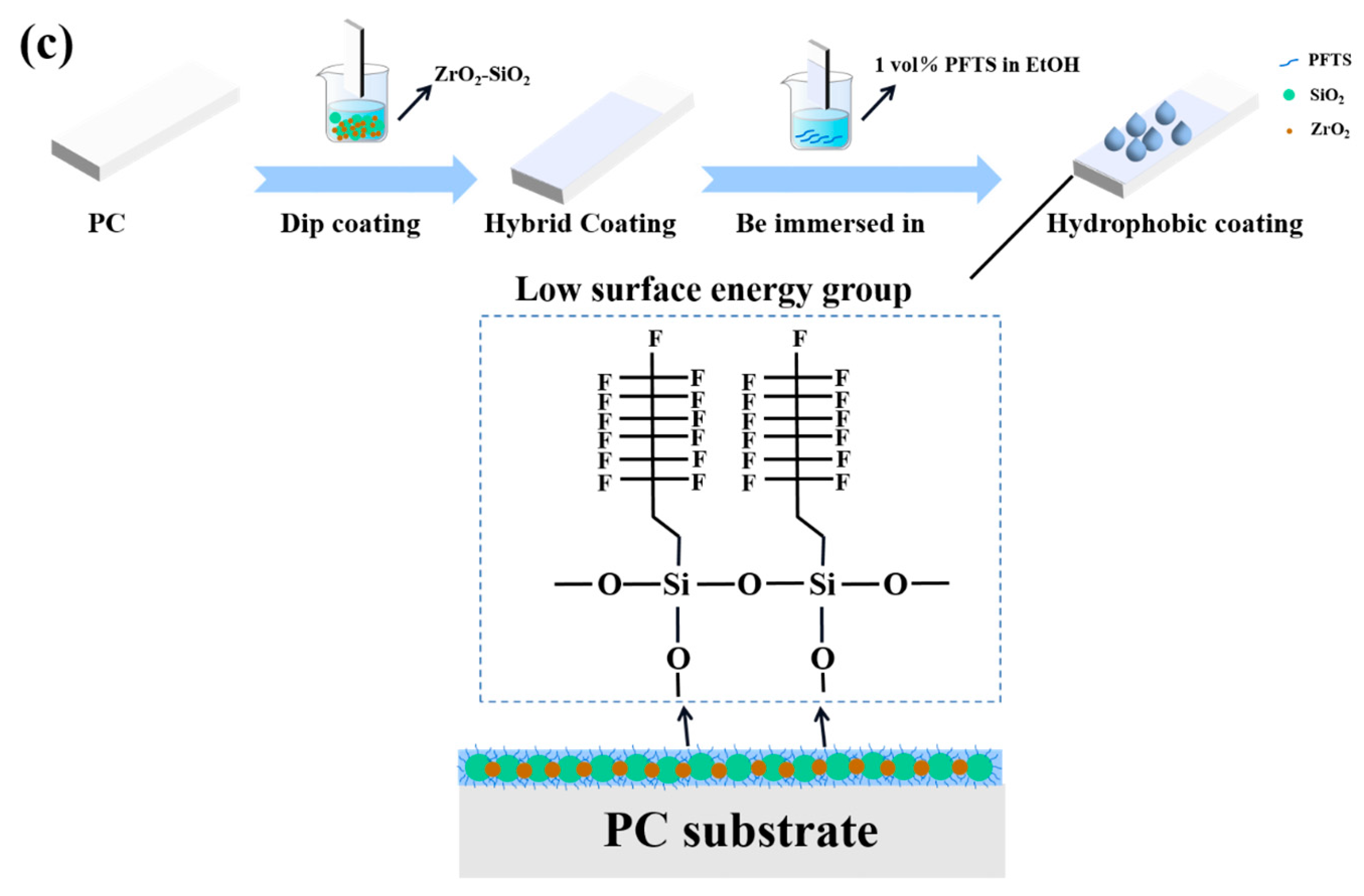

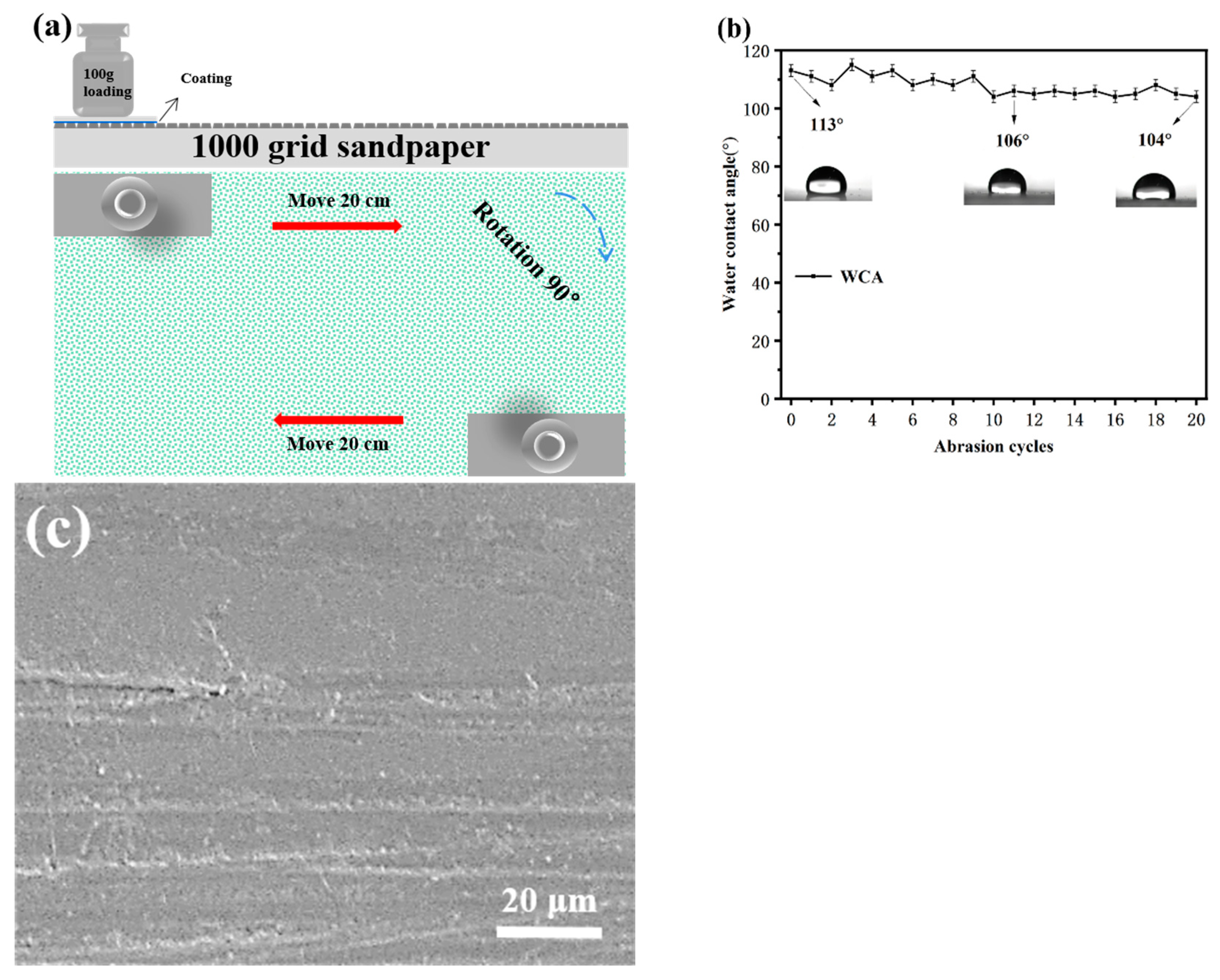
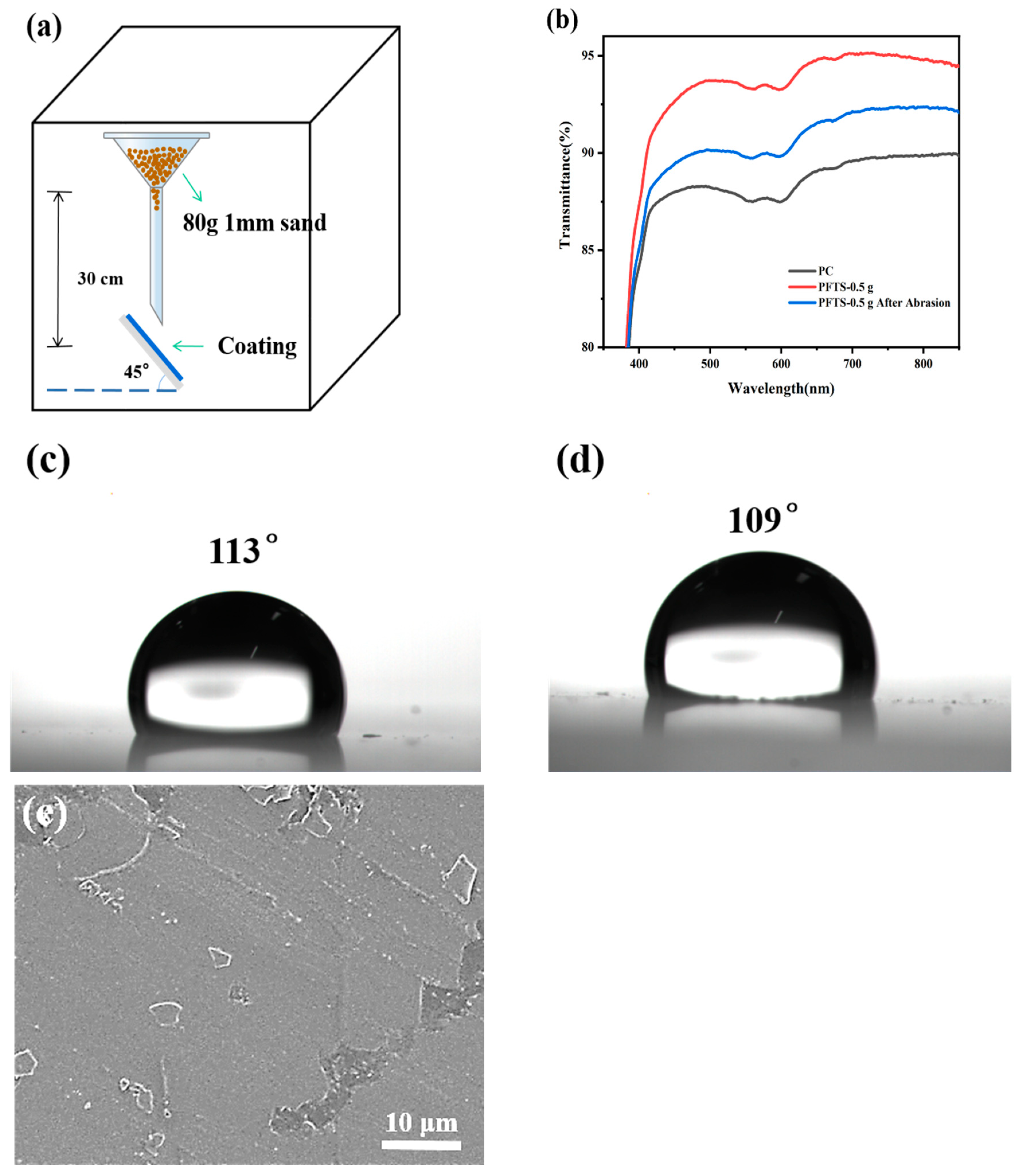

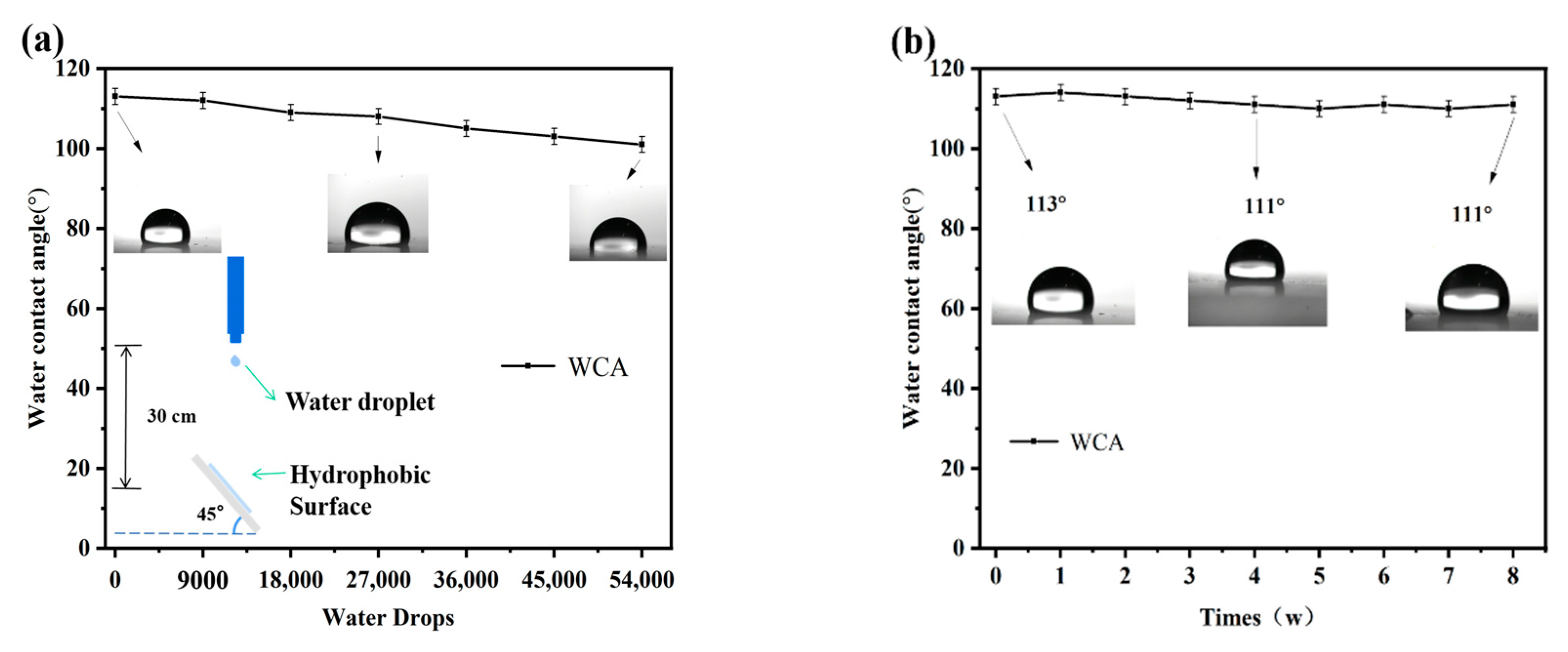
| ZrO2 Sol (g) | Average Transmittance [%] | Peak Transmittance [%] |
|---|---|---|
| Bare PC | 88.6 | 90.0 |
| 0.25 | 93.8 | 94.7 |
| 0.50 | 93.9 | 95.1 |
| 1.00 | 93.5 | 95.1 |
| 1.50 | 92.5 | 95.0 |
| 2.00 | 92.9 | 95.0 |
| 2.50 | 92.3 | 95.0 |
Disclaimer/Publisher’s Note: The statements, opinions and data contained in all publications are solely those of the individual author(s) and contributor(s) and not of MDPI and/or the editor(s). MDPI and/or the editor(s) disclaim responsibility for any injury to people or property resulting from any ideas, methods, instructions or products referred to in the content. |
© 2023 by the authors. Licensee MDPI, Basel, Switzerland. This article is an open access article distributed under the terms and conditions of the Creative Commons Attribution (CC BY) license (https://creativecommons.org/licenses/by/4.0/).
Share and Cite
Zhang, B.; Xia, R.; Yan, Y.; Liu, J.; Guan, Z. Highly Transparent and Zirconia-Enhanced Sol-Gel Hybrid Coating on Polycarbonate Substrates for Self-Cleaning Applications. Materials 2023, 16, 3138. https://doi.org/10.3390/ma16083138
Zhang B, Xia R, Yan Y, Liu J, Guan Z. Highly Transparent and Zirconia-Enhanced Sol-Gel Hybrid Coating on Polycarbonate Substrates for Self-Cleaning Applications. Materials. 2023; 16(8):3138. https://doi.org/10.3390/ma16083138
Chicago/Turabian StyleZhang, Bing, Ruohan Xia, Yao Yan, Jia Liu, and Zisheng Guan. 2023. "Highly Transparent and Zirconia-Enhanced Sol-Gel Hybrid Coating on Polycarbonate Substrates for Self-Cleaning Applications" Materials 16, no. 8: 3138. https://doi.org/10.3390/ma16083138
APA StyleZhang, B., Xia, R., Yan, Y., Liu, J., & Guan, Z. (2023). Highly Transparent and Zirconia-Enhanced Sol-Gel Hybrid Coating on Polycarbonate Substrates for Self-Cleaning Applications. Materials, 16(8), 3138. https://doi.org/10.3390/ma16083138





